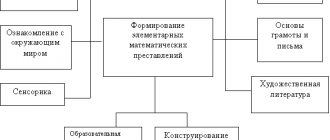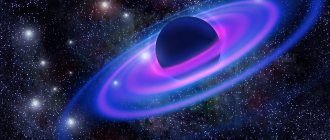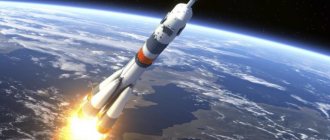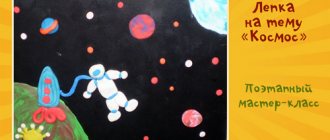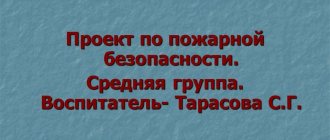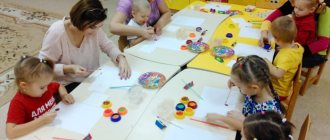Interactive children's presentation “Journey into Space”
Author:
Yagovkina Marina Vladimirovna,
teacher,
highest qualification category
MADO kindergarten No. 126 in Tyumen
Journey into space
(integrated educational activities)
Program content:
- Practice the ability to restore the order of numbers in ascending order.
- Recognize familiar geometric shapes, make a figure from a geometric constructor according to a diagram.
- Test your ability to form a whole from parts and name each part.
- Fix the countdown, the composition of the numbers within 4.
- Continue to develop the ability to divide words into syllables, choose words with the same root, name the first letter in a word
- Expand your understanding of constellations and planets of the solar system.
- Develop logical thinking, imagination, and reasoning skills.
Materials:
- Ø Multimedia installation
- Ø Rocket diagram, geometric constructors (for each child);
- Ø Stars: 3 large with number houses, 12 small with numbers;
- Ø Tape recorder, star music, distress signal;
- Ø Planet Jupiter divided into 4 parts and two other cosmic bodies;
- Ø Star, star stickers
Educator: Hello, guys! Today we have guests, let's say hello to them. (Slide 2)
Today we will go on a journey with you. What can you go on a trip with? (Slide No. 3)
Children's answers: by train, by car, by bus...
Educator: I suggest you guess what we are going on.
Game “Add the letters in ascending order of numbers” (Slide No. 4)
I have the name of this transport here. (the teacher opens the box, and there are letters and numbers on magnets), for this we need to arrange all the numbers in ascending numerical order and we will find out what we will take on the journey.
The child puts the numbers in order and reads the word: ROCKET.
| 1 | 2 | 3 | 4 | 5 | 6 |
| R | A | TO | E | T | A |
Educator: Where can we go on a rocket?
Children's answers: to space, to the moon...
Educator: Today we will go on a journey on a rocket into space, we will make stops on various planets. Where is our rocket? Here it is (Slide No. 5).
What geometric shapes does our rocket consist of?
Children's answers: from a triangle, a rectangle, a circle
Educator: Let's go to the table and build the same rockets.
Children use their geometric construction set to build rockets.
Educator: Well done! Now it's time to hit the road. We begin launching the rocket: 10, 9, 8, 7, 6, 5, 4, 3, 2, 1. (Slide No. 6)
— Guys, the rocket won’t start. We forgot the key to start the rocket.
Graphic dictation:
8 cells right, 2 cells up, 4 cells right, 5 cells down, 4 cells left, 2 cells up, 4 cells left, 2 cells up, 4 cells left, 3 cells down, 1 cell left, 1 cell up, 1 cell left, 1 cell down, 1 cell left, 3 cells up, 1 cell left, 1 cell up.
- Whoever completed the task correctly received the key to start the rocket. (Slide No. 7)
And now that we have the key, let’s start the rocket again: 10, 9,8,7,6, 5, 4, 3, 2, 1, launch (Slide No. 8)
Cosmic music sounds (Slide No. 9)
- So we fly, we enter weightlessness.
Children move in different directions and fly.
Educator: Look out the windows, we are flying through different constellations:
- This is Ursa Major. Count how many stars are there in this constellation? (Slide No. 10)
Children: Seven.
Educator: This constellation is called Orion, count how many stars are in this constellation? (Slide No. 11)
Children: Eight.
Educator: This constellation is called Cassiopeia, count how many stars are in it? (Slide No. 12)
Children: Five.
All these constellations are available for observation in our country at any time of the year.
Educator: Our ship flew up to a cluster of stars. So many stars! What are these stars in size? (Slide No. 13)
Children: Big and small.
Educator: Let's collect the stars. Boys collect big stars, and girls collect small ones.
Children collect stars.
Educator: Well done, guys! Oh, these are not ordinary stars.
Big stars are houses for little stars. We need to distribute the stars among the houses.
Game "Number Houses"
Educator: Guys, are we flying further?
A distress signal is heard (Slide No. 14)
Educator: Guys, the planet Jupiter is asking for help. A meteorite hit the planet and it split into pieces. The parts scattered in space and mixed with other parts of cosmic bodies, comets and asteroids. Task: assemble a planet from 4 equally sized parts.
Children come to the table and together collect planets and find the desired planet.
Educator: Which of these planets is Jupiter?
Children's answers. (Slide No. 15)
Educator: How did you guess?
Children: Planet Jupiter broke into four parts.
Educator: What is the name of each part of the planet?
Children: one fourth (Slide No. 16)
Educator: Attention! We are descending to the nearest planet. We leave the ship. It wouldn't hurt to warm up a little.
Physical exercise “Let's be cosmonauts” (Slide No. 17)
One, two - there is a rocket. Children raise their hands up, Three, four - take off soon. spread their arms to the sides, To fly to the Sun they make a circle with their arms, Cosmonauts need a year But on the road we are not afraid, arms to the sides, bending the body, Each of us is an athlete. squatting, bending and unbending their arms. Flying over the Earth at the elbows, raising their arms up. Let's say hello to her. and wave
Educator: To go further on our journey, we need to make our way through the asteroid belt. (Slide No. 18)
We will be saved if we find the way correctly. We need to find extra words.
Game "Fourth wheel"
- 1. Space, astronaut, spacesuit, space (Slide No. 19)
- 2. Asterisk, stellar, star, asteroid (Slide No. 20)
- 3. Earth, earthlings, earthly, planetary. (Slide No. 21)
- 4. Lunatic, Moon, Lunar, crater (Slide No. 22)
Educator: Why is this word superfluous?
Children's answers
Educator: Guys, it’s time for us to return to Earth (Slide No. 23)
We returned from the flight
And they landed on Earth.
Our journey is over.
- Look, a star fell from the sky! (Slide No. 24)
They say that when a star falls, you can make a wish and it will definitely come true. Do you want to make a wish?
Children pass the star and make wishes.
Educator: I also want to make a wish: that you will always be as friendly, brave, smart, quick-witted as during our journey. And the star brought you little gifts: little stars - stickers. (Slide No. 25)
From the portal administration: Presented demo version for review. The full version will be in the multimedia album of the virtual exhibition, which each participant will receive.
Dear teachers and parents - participants of the exhibition!
On June 2, 2015, a solemn ceremony of awarding the winners of the regional methodological exhibition “Modern educational environment of kindergarten and family” took place at the information and exhibition complex of the Tyumen Regional Duma. Details >>>
From June 8 to June 10, 2015, teachers from Tyumen received certificates of exhibition participants and multimedia albums with the full version of the exhibition at the Grant Center for the Development of Creativity for Children and Youth at the address: Profsoyuznaya St., 52. tel. for inquiries: 685-321,
June 9, 2015 Diplomas, certificates and gifts were sent to the winners and participants of the Exhibition of the south of the Tyumen region, Yamal-Nenets Autonomous Okrug and Khanty-Mansi Autonomous Okrug-Yugra by registered parcel post to the address of the preschool educational institution. Details >>>
Share
Presentation "What they fly into space on"
Interest in Space awakens in a person very early, literally from the first steps. The mysteries of the Universe always excite the imagination, from early childhood to old age. The sun, the moon, the stars are at the same time so close, and at the same time so far away. Remember your childhood, how interesting it was to look at the night sky. How to support a child's interest in the unknown? What methods can be used to interest a child and help him learn new, interesting information about space? We believe that the project method will allow children to learn complex material through a joint search for a solution to a problem, thereby making the cognitive process interesting and motivational. Work on the project is complex in nature, permeates all types of activities of preschoolers, takes place in everyday life and in special integrated classes. Otherwise, children's knowledge will remain confused, fragmentary, incomplete, and disconnected from modern life. Project activities develop children’s creative activity and help the teacher himself develop as a creative person. This project is based on preschoolers’ thirst for knowledge, desire for discovery, curiosity, need for mental impressions, and our task is to satisfy the needs of children, which in turn will lead to intellectual and emotional development. This project is aimed at developing children’s horizons, developing their cognitive activity, nurturing patriotic feelings (pride in Russian cosmonauts - space pioneers), moral values (good, friendly relations, etc.).
When implementing the “We and Space” project, the following approaches were used:
— in the process of cooperation and interaction, communication skills develop, dialogical speech develops;
— joint productive creative activity creates an atmosphere of goodwill, mutual assistance, and a favorable emotional climate;
— by implementing a game project, participants in the educational process “parents – children – educators” create a triad of community;
— children develop their own, personal attitude towards what they see and hear, a feeling of joy from contact with cosmic beauty, etc.
Target:
Formation of ideas about outer space and human space exploration in older preschool children
Tasks:
1. Continue to expand children's understanding of the diversity of space. Tell children about interesting facts and events of space.
2. Give children the idea that the Universe is made up of many stars. The Sun is the star closest to Earth. Clarify ideas about planets and constellations.
3. To give children knowledge about human exploration of outer space, about the importance of space research for the life of people on Earth. Introduce the first cosmonaut Yu.A. Gagarin.
4. Foster a sense of pride for your homeland.
5. Involve parents in joint activities to celebrate Cosmonautics Day.
Presentation for the lesson (preparatory group) on the topic: Presentation on the topic “Space” - presentation

PRESENTATION Topic: Space
The miracle bird, scarlet tail, flew into a flock of stars.
He is not a pilot, not a pilot, He is not flying a plane, But a huge rocket. Children, who, tell me, is this?

For thousands of years people walked the Earth, but could not see it all at once. On November 4, 1957, our country opened a new space era to the world. On this day the first artificial Earth satellite was launched. It weighed 83.6 kilograms and was shaped like a ball with a diameter of 58 centimeters. Now, although not with their own eyes, but with the help of equipment, people were able to see their planet from space.
On the second artificial satellite, the dog Laika was launched into space and circled the Earth.
On April 12, 1961, the planet was shocked by unexpected news: “Man in space! Russian, Soviet! The centuries-old dream of people about flying to the stars has come true. On a sunny morning, a powerful rocket launched the Vostok spacecraft into orbit with Earth's first cosmonaut Yuri Gagarin on board.
Yuri Gagarin took a seat in the cockpit, the command “Start!” was sounded. "Go!" The voice of the first cosmonaut was heard in the radio horns. The engines roared, the rocket took off from the Earth and went into the sky. Such a miracle has never happened A man is rushing into cold space! The name Gagarin, Yuri Gagarin, has entered into the memory of people forever. His feat is legendary! The world is grateful to the daredevil, the Motherland is proud of him! O. Vysotskaya
What did Gagarin experience in the ship? What did he see through the portholes? Listen to an excerpt from his memoirs. “When the ship entered orbit, weightlessness appeared. I left the chair and hung between the ceiling and the floor of the cabin. Everything around me became easier. “Earth” asked what I was seeing, and I said that mountain ranges, large rivers, large forests, spots of islands, and the coastal edge of the seas were clearly visible.”
The first manned flight in space lasted more than an hour, namely 108 minutes. During this time, the Vostok ship flew around the entire globe and landed in a precisely specified area.
The ship landed on a plowed field. And then an interesting episode occurred, which Yuri Gagarin later talked about. “When I stepped onto solid ground, I saw a woman and a girl standing next to a spotted calf and watching me with curiosity. I went to them. They headed towards. But the closer they came, the slower their steps became. I was still in a bright orange spacesuit, and its unusual appearance probably frightened them. They have never seen anything like it before..."
The Vostok spacecraft circled the Earth only once. And a modern space station has been in space for many years; this is a real space house in which astronauts live for many months.
People began to create such stations for long flights into space. This is a real “space house”, which is constantly in space and where astronauts work for many months.
At orbital scientific stations, astronauts from different countries conduct research on the Earth and outer space. Sometimes they leave the station and go into outer space.
The “wings” of the space station are solar panels. They “catch” the sun's rays and turn them into electric current. And the current illuminates, heats the station and powers all scientific instruments. The “wings” of the space station are solar panels. They “catch” the sun's rays and turn them into electric current. And the current illuminates, heats the station and powers all scientific instruments.
You already know that our planet has a natural satellite. What is it called? But man was able to create and launch artificial Earth satellites into space. The Russian word satellite has entered all languages of the world. Nowadays there are many artificial satellites constantly in space. Why are they needed?
Communication satellites carry out television transmissions to remote corners of the Earth. Their help is necessary for radio and telephone communications.
MARINE NAVIGATION TV BROADCASTING MOBILE COMMUNICATION
Nowadays, astronauts fly into space quite often, we are already accustomed to it. But when the first astronaut flew into space, people all over the world experienced amazement and delight.
commander of the TPK Soyuz TMA-M, flight engineer of ISS-30/commander of ISS-31, instructor-cosmonaut-tester of the Federal State Budgetary Institution "Research Institute of Cosmonaut Training Center named after Yu.A. Gagarin", Roscosmos, Hero of the Russian Federation, cosmonaut 2nd class, 102- 1st cosmonaut of the Russian Federation, commander of the Soyuz TMA-M spacecraft, flight engineer of the ISS-30/commander of the ISS-31, instructor-cosmonaut-tester of the Federal State Budgetary Institution "Research Institute of Cosmonaut Training Center named after Yu.A. Gagarin", Roscosmos, Hero of the Russian Federation, cosmonaut of the 2nd class, 102nd cosmonaut of the Russian Federation OLEG DMITRIEVICH KONONENKO

THANK YOU FOR YOUR ATTENTION!!!
Project "Cosmos"
Kindergarten preparatory group
Project content
Project name: "Space".
Project type : educational, creative, informational.
Duration : medium-term (1 month).
Content : research-creative, informational (practice-oriented).
By the nature of contacts : child-parent, within the preschool educational institution.
Participants: children of the preparatory group, teacher, parents.
Educational areas: “Cognitive development”, “Socio-communicative development”, “Speech development”, “Artistic and aesthetic development”, “Physical development”.
Problem: Arseny (pupil of group No. 2) brought an encyclopedia about space to the group. Looking at the illustrations in the encyclopedia, the children did not understand much. It turned out that preschoolers know little about the history of human space exploration and about outer space in general.
We tried to solve this problem using the project method. It is easier for children to understand complex material about space through a joint search for a solution to the problem with an adult (teacher or parents).
Relevance:
An important means of understanding the surrounding world is not only the surrounding nature, but also the unknown world of the Universe. It attracts his attention, forces him to include various senses in the process of observation, and therefore activates the initial moments of cognition - sensation and perception. Currently, it is necessary to form cognitive activity in children through various forms of activity: games, experiments, experiences, observations.
Curiosity and cognitive abilities do not arise on their own; they must be developed. Unfortunately, we noticed that in the “Origins” Program edited by L.A. Paramonov, T.I. Aliev, A.N. Davidchuk et al. in the preparatory group do not sufficiently cover the section “The World We Live In” on the topic “Space”, so there was a need to work on the “Space” project.
And we decided to organize the Cosmos project.” We believe that this methodological development will allow preschool children to develop an integrated picture of the world (an idea of outer space , the solar system and its planets, human space exploration ) , a sense of patriotism, pride and respect for their country.
Project goals: to create conditions for children to develop an idea of the world around them, so that the world becomes a source of knowledge and mental development of the child (an idea of outer space, the solar system and its planets, human space exploration); promote the development of cognitive and intellectual abilities of children together with parents (legal representatives).
Project objectives:
- To form and expand children’s ideas about the history of the development of astronautics;
- Form initial ideas about space, the solar system, planets, the diversity of outer space, etc.;
- To form children’s knowledge about the people who discovered space to humanity;
- To promote the formation in children of interest in space and its knowledge;
- Develop the creative abilities of preschoolers in various activities;
- Develop the skills to analyze, reason, generalize, compare, contrast, and draw conclusions;
- To cultivate respect for people who opened a “window” to space for humanity;
- Foster love for your country, feelings of patriotism and pride in the country.
For parents:
- Involving parents in the pedagogical process in preschool educational institutions, strengthening parents’ interest in cooperation with the kindergarten;
- Help parents establish emotional contact with their child, expanding the range of their nonverbal communication;
- Promote emotional bonding between parent and child.
Hypothesis:
During the implementation of the “Space” project, children of senior preschool age will form ideas about space; Concretizes knowledge about the planets of the solar system, constellations, meteorites, and generates interest in unknown facts from the history of space. Children will learn to analyze existing facts, establish cause-and-effect relationships, and draw conclusions.
This work will bring visible results provided that it is implemented in close cooperation between the family and the preschool educational institution.
Expected result:
- Children’s assimilation of knowledge and ideas about space (idea about outer space, the Solar system and its planets, human space exploration);
- Development of an active, independent, creative personality;
- Raising a patriotic feeling in a preschooler, the desire to be brave, strong and resilient;
- Involving parents in joint activities with the child.
Stages and timing of the project:
Work on the project was carried out in stages:
Stage 1 - Information and accumulation stage
(1 week - from March 19 to March 23, 2022):
- Identification of the level of knowledge about space in children of senior preschool age (diagnostics);
- Conduct a survey of parents on the topic of the project;
- Prepare folders with illustrations on the project topic;
- Select poems, riddles, active and didactic games on the topic of the project;
- Develop notes for educational activities with older children on the topic of the project;
- Collection and analysis of methodological, popular science, children's and fiction literature for adults and children, illustrated material on the topic;
- Development of a work plan for project implementation;
- Including project cycles in the long-term work plan;
- Involve parents of students in active interaction, intensify interaction in the “teacher-child-parent” system.
Stage 2 - Organizational and practical stage
(2 weeks – from March 26 to April 6, 2022):
- Reading methodological and fiction literature;
- Examination of illustrations, photographs on the topic of the project;
- Conducting a series of thematic classes;
- Working with parents to replenish the RPPS group on the topic of the project;
- Watching presentations, educational and animated films for children about space in preschool educational institutions and beyond;
- Organization of an exhibition of joint creative works of children and parents;
- Identification of the level of knowledge about space in children of senior preschool age (final diagnosis);
Stage 3 – Presentation and final stage
(1 week - from April 9 to April 13, 2022):
- Exhibition of children's activity products;
- Exhibition of card files “The Universe and Its Secrets”, “Great Cosmonauts”, “Planets of the Solar System”;
- Exhibition of creative activities of children and parents “Space and Its Inhabitants”;
- Presentation of the “Space” project to preschool teachers.
The implementation of the “Cosmos” project made it possible to form in children the necessary ideas about space (the idea of outer space, the solar system and its planets, human space exploration), the development of children’s cognitive and intellectual abilities, the creation of conditions for the development of cognitive speech activity of preschoolers, the desire for independent knowledge .
Educational areas : social and communicative development, cognitive development, speech development, artistic and aesthetic development, physical development.
Joint activities of children and teachers.
Goal: to activate cognitive interest in space, to consolidate children’s knowledge about the diversity of outer space; encourage search skills; enrich children's speech.
Cognition
Conversations:
"What is space?" Purpose: to give children an idea of the planets of the solar system, the sun, stars, the first flight into space, to find out children’s knowledge on this issue;
"Blue Planet - Earth." Goal: explain to children what a telescope and outer space are, show how beautiful our Earth is from space;
"The Moon is the Earth's satellite". Goal: to find out children’s ideas about the Moon, month, expand knowledge about the lunar surface, a. Goal: expand children's understanding of the planets of the solar system;
“The sun is the source of life on Earth.” Purpose: to clarify children’s knowledge about the sun, its shape; explain what it consists of;
OOD:
Cognition “I want to be an astronaut.” Purpose: to introduce the biography of the first cosmonaut Yu. A. Gagarin; expand your understanding of modern professions; talk about the work of Russian cosmonauts in space these days.
Communication “Nagibin Yu.M. Stories about Gagarin. Purpose: to introduce the biography of Yu. Gagarin. Learn to comprehend the content of what you read; cultivate a sense of pride in the first space explorers; lead to an understanding of such moral and volitional qualities as kindness, perseverance, fearlessness, and hard work.
Reviewing illustrations and encyclopedias on the topic of the project;
Watching videos “Underwater World”.
Experimental activities:
Experiments: “How to see stars without rays”, “Why you can’t see stars during the day”, “Why the Moon doesn’t fall on the Earth”, “Who ate the moon”, “How the change of day and night occurs.”
Reading fiction
Y.K. Golovanov “The Road to the Cosmodrome”, V. Kashchenko “Constellation of Dragons”, P.O. Klushantsev “What the telescope told us”, O.A. Skorolupova “Conquest of Space”, N. Nosov “Dunno on the Moon”, poems about space, riddles about space.
Socialization
Didactic games: “Magic Planets”, “Find the Differences”, “Labyrinth”, “Restore Order in the Solar System”, “Find the Extra One”, “Pick up the Constellation”, “Find the Missing Rocket”, “Where the Rockets Are Flying”.
Productive activities:
HER (construction) “Cosmonauts near the rocket.” Purpose: to study the name of the components of the rocket; independently construct a rocket and astronaut figures from natural materials, follow the rules of safe work with piercing and cutting objects.
HER (from activity) “Space fantasy”. Goal: expand children's horizons and knowledge about space; develop color perception; maintain interest in visual arts;
HER (applique) “Flight to the Moon”. Goal: learn to convey the shape of a rocket using the technique of symmetrical cutting out of paper, cut out figures of people in spacesuits from paper folded in half; consolidate the ability to complement the picture with objects that are suitable in meaning; develop a sense of composition and imagination.
Constructive games : “Cosmodrome” (from a wooden construction set), “Spaceship” (from a Lego construction set)
Story-based role-playing games “Space”, “Cosmonauts”, “Accident on a space station”, etc.
Physical development
Outdoor games: “Fast rockets are waiting for us”, “Space relay race”, “Rocket launch site”, “Weightlessness”, “Sun and rain”, “Sun champion”.
Project activity product:
For teachers:
- Design of the folder “Methodological development. Project "Cosmos";
- Creation of card files and visual aids “The Universe and its secrets”, “Great astronauts”, “Planets of the solar system”;
- Creation of electronic files on the project theme (presentations: “Fascinating Astronomy”; “Conquerors of Space”; “April 12 - Cosmonautics Day”; video material: cartoons “Belka and Strelka”, “Treasure Planet”, “Dunno on the Moon”, “Monkeys in space", "Hedgehog in the Nebula" (Smeshariki), "Space Jam", documentary footage about the first human launch into space);
- Formalization of the work as a project, presentation of it to preschool teachers.
For children:
- Replenishment of knowledge and ideas about the history of the development of astronautics;
- Formation of initial ideas about space, the solar system, planets, the diversity of outer space, about the people who opened space to humanity;
- Introduction to games, poems, songs, literature on the topic “Space”;
- Mastering the skills of comparing, observing, analyzing, asking questions, drawing conclusions;
- Acquiring social communication skills with adults;
- Showing respect for the people who discovered outer space to humanity;
- Developing a sense of patriotism, pride and respect for your country.
For parents:
- Involving parents in the pedagogical process in preschool educational institutions, strengthening parents’ interest in cooperation with the kindergarten;
- Replenishment of the RPPS group with attributes for the plot-role-playing game “Space”;
- Replenishment of the RPPS group with literary works : Poems by T. Larin “Heroes - Cosmonauts”, G. Sapgir “Comet”, Yu. Sinitsyn “Ursa Major”, “Constellations”, R. Aldonin “Saturn”, “Moon”, “Comet”, “Stars”, V. Stepanov “Yuri Gagarin”, G. Lagzdyn “Cosmonaut”, V. Lepilov “Space Tale”, V. Borodin story “Rocket”, N.I. Andreev “How a man learned to fly”;
- Replenishment of the RPPS group with musical works : “You know what kind of guy he was” by A. Pakhmutov, “14 minutes before the launch ...”, “Earth in the porthole”, “Our Starship”, O. Emelyanova, “March of Young Cosmonauts” by Magidenko, music “ Magic Flight” by Ekam, composition “Flight” by the ensemble “Space”, “And apple trees will bloom on Mars” by V. Muradeli, “We are flying into Space to work”;
- Replenishment of the RPPS group with video materials for joint viewing with children (cartoons of the USSR: Soyuz Cartoon) : “The Secret of the Red Planet”, “Mysterious Planet”, “Return”, “Return from the Stars”, “Main Star”, “Murzilka on the Satellite”, “ Dunno on the Moon", "Stories about Space";
- Replenishment of the RPPS group with encyclopedias, illustrations, posters on the topic of the project;
- Replenishment of the RPPS group with didactic games : “Magic Planets”, “Find the Extra One”, “Find the Differences”, “Labyrinth”;
- Creating joint creative works with children to participate in an exhibition at the group level on the topic “Space and its inhabitants ”;
- Emotional rapprochement between a parent and a child by introducing children to space outside the preschool educational institution.
The implementation of the “Cosmos” project made it possible to form and expand the understanding of senior preschool children about space , to concretize knowledge about the planets of the solar system, constellations, meteorites, and the interest of preschoolers in unknown facts from the history of space was formed, as evidenced by the results of the final diagnostics to identify the level of knowledge in children senior preschool age on the topic of the project. Children learned to analyze existing facts, establish cause-and-effect relationships, and draw conclusions.
Children and parents showed interest in space in general and reflected their impressions in joint creative and research activities, which allowed them to emotionally become even closer to each other.
Thus, we recommend that preschool teachers develop and implement the “Cosmos” project for use in working with children and parents.
Bibliography
- Great encyclopedia. Space and astronomy: questions and answers. - M.: OLMA Media Group, 2013.
- Goryachev A.V., Klyuch N.V. Everything is spot on. A manual for preschoolers. - M., 2006.
- Donina O.I., Khamidullina L.A. Journey through the Universe. Classes on developing a natural-scientific picture of the world in preschoolers. — Publisher: ARKTI, 2009.
- Emelyanova E. Tell children about astronautics. - M.: Mosaic - Synthesis, 2015.
- Klushantsev P.O. What did the telescope tell you? – L.: Children's literature, 1980.
- Kochemasova E.E., Vakhrushev A.A. The world around us for older preschoolers. - M.: Balas, 2015. - 80 p.
- Levitan E.P. “The Birth of “Preschool Astronomy” // Earth and the Universe. - 2010. - No. 6.
- Mayorova G. Games and stories about space. – M.: List, 1999.
- Marupova E.V. Familiarization of preschoolers with the world around them. - M.: Detstvo-Press, 2014. - 128 p.
- Panikova E.A., Inkina V.V. Conversations about space. Methodological manual. - M.: TC Sfera, 2010.
- Skorolupova O.A. Conquest of space. — 2nd ed. - M.: Scriptoria Publishing House 2003, 2010.
- Tyatyushkina N.N., Ermak O.A. Paths of the Universe: methodological recommendations for the formation of basic astronomical knowledge in older preschoolers. - Mozyr: LLC Publishing House "White Wind", 2006.
- Shorygina T. A. Children about space and Yuri Gagarin - the first cosmonaut of the Earth: Conversations, leisure activities, stories. M.: TC Sfera, 2011. - 128 p.
